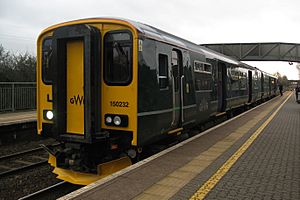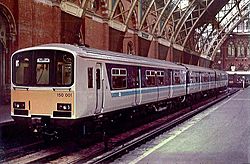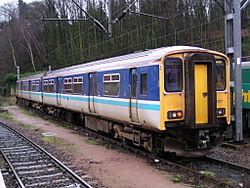British Rail Class 150 facts for kids
Quick facts for kids British Rail Class 150 "Sprinter" |
|
|---|---|

150232 at Worle
|
|
| In service | 1984 - present |
| Manufacturer | BREL |
| Family name | Sprinter |
| Constructed | 1984 - 1987 |
| Refurbishment | Various |
| Number built | 137 |
| Formation | 2 or 3 cars, all power |
| Capacity | Depends on refurbs |
| Operator(s) | Arriva Trains Wales London Midland First Great Western Northern Rail London Overground |
| Line(s) served | Many |
| Specifications | |
| Car length | 64 feet (19.5 metres) |
| Width | 9 feet (2.8 metres) |
| Maximum speed | 75 miles per hour (121 km/h) |
| Weight | 35.8 tonnes |
| Prime mover(s) | Diesel |
| Safety system(s) | AWS, TPWS |
| Coupling system | BSI Compact |
| Track gauge | Standard gauge (4 ft 8½ in) |


The British Rail Class 150 "Sprinter" trains are special diesel multiple units (DMUs). They were built by a company called BREL between 1984 and 1987. These trains were designed to be a modern replacement for older, less efficient trains. A total of 137 of these units were made. They helped improve train travel across many parts of Britain.
Contents
What are Class 150 Sprinter Trains?
Class 150 Sprinters are a type of train that carries its own engine. This means they do not need a separate locomotive to pull them. They are called "Sprinters" because they were designed for faster, more efficient local and regional services. These trains can run on tracks that are 4 feet 8½ inches wide. This is known as Standard gauge railway.
How Many Carriages Do They Have?
Most Class 150 trains have either two or three carriages. Each carriage has its own engine, making the whole train powerful. This design helps them speed up and slow down quickly. This is very useful for routes with many stops.
Why Were Sprinters Built?
In the 1980s, British Rail wanted to modernize its train fleet. They needed new trains that were more comfortable and reliable. The Class 150 Sprinters were part of this big upgrade. They replaced many older trains that were built in the 1950s and 1960s. These new trains offered a much better experience for passengers.
Where Do Class 150 Trains Operate?
Class 150 Sprinters have served many different train companies over the years. They are still in use today across various parts of the UK.
Current Operators
Today, you can find Class 150 trains running with several companies. These include Arriva Trains Wales, London Midland, and Great Western Railway. They are also used by Northern Rail and London Overground. This shows how versatile and reliable these trains are.
Common Routes and Services
These trains are often used for local and regional journeys. They connect towns and cities, making it easy for people to travel for work or school. They are also used on some longer routes. Their design allows them to handle different types of railway lines.
Inside a Class 150 Sprinter
The inside of a Class 150 train has changed over time. Many units have been updated to make them more modern and comfortable.
Passenger Comfort and Seating
When they were first built, the trains had basic seating. Over the years, many have been refurbished. This means they have been updated with new seats and interiors. The capacity, or how many people can fit, depends on these updates.
Speed and Safety Features
Class 150 Sprinters can reach a top speed of 75 miles per hour (about 120 kilometers per hour). They are equipped with important safety systems. These include the AWS and the TPWS. These systems help the driver operate the train safely. They warn the driver about signals and help prevent accidents.
Images for kids
-
Northern Rail refurbished Class 150/2 Sprinter No. 150277 at York
-
Wessex Trains refurbished Class 150/2 No. 150243 at Bristol Temple Meads
-
Transport For Wales Class 150 Sprinter unit 150231 passes Llanfairpwll railway station with a service to Crewe railway station. This train is coupled with a British Rail Class 158.
-
Silverlink liveried, London Overground operated Class 150/1 Sprinter No. 150120 at Gospel Oak, with a service bound for Barking











